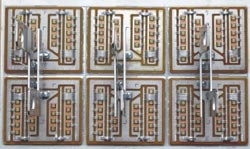New SiC Diodes Make Converters More Efficient

<br>
In the recently ended project MV-SiC, these diodes were tested in the sort of commercial converters used for large drives. SiC diodes reduce the complexity of the system, and because they have lower losses, they also increase energy efficiency.
Another result is that the switching frequency of converters can be increased by approximately a third, which boosts the performance and speed range of the drives. Siemens managed the project, and it was funded by the German Federal Ministry of Education and Research as part of the program Power Electronics for Raising Energy Efficiency.
With frequency converters electric motors can operate at variable-speed. When used for large pumps, compressors, or ships, such motors consume up to 70 percent less power than motors without any speed control. Considering that drives of this kind have an output of several megawatts, the savings are quite significant. Outputs on that scale require converters that produce voltages of several kilovolts (kV). In the past, such converters were made of conventional silicon semiconductors.
In the course of the project, the partners Infineon, Curamik Electronics, the TU Dresden, and experts from Siemens Drive Technologies and global research department Corporate Technology (CT) studied diode modules based on the semiconductor material silicon carbide (SiC) which have a cut-off voltage of 6.5 kilovolts (kV) and can withstand currents of up to 1.2 kiloamperes (kA).
By connecting bipolar SiC high-voltage diode chips in parallel, it was possible to construct functional SiC diode modules with the desired electrical parameters. To optimize the switching behavior, the partners built a fully digital drive circuit. This allowed them to achieve high switching frequencies and a high switching speed, which resulted in much lower turn-on losses. The work done by Siemens CT focused on the thermal behavior of the chips and diode modules. These are crucial factors for the reliability and lifetime of the diode modules, because the conducting-state voltage decreases with increasing temperature in a SiC diode.
Experts from Siemens Drive Technologies tested the new modules as midpoint diodes in Sinamics GM150 converters. This standard converter system for single drives was built with a 6.5 kV SiC diode module, which reduces the complexity and, therefore, the material requirements of the design while increasing efficiency.
Media Contact
More Information:
http://www.siemens.com/innovationnewsAll latest news from the category: Power and Electrical Engineering
This topic covers issues related to energy generation, conversion, transportation and consumption and how the industry is addressing the challenge of energy efficiency in general.
innovations-report provides in-depth and informative reports and articles on subjects ranging from wind energy, fuel cell technology, solar energy, geothermal energy, petroleum, gas, nuclear engineering, alternative energy and energy efficiency to fusion, hydrogen and superconductor technologies.
Newest articles

Bringing bio-inspired robots to life
Nebraska researcher Eric Markvicka gets NSF CAREER Award to pursue manufacture of novel materials for soft robotics and stretchable electronics. Engineers are increasingly eager to develop robots that mimic the…

Bella moths use poison to attract mates
Scientists are closer to finding out how. Pyrrolizidine alkaloids are as bitter and toxic as they are hard to pronounce. They’re produced by several different types of plants and are…

AI tool creates ‘synthetic’ images of cells
…for enhanced microscopy analysis. Observing individual cells through microscopes can reveal a range of important cell biological phenomena that frequently play a role in human diseases, but the process of…





















